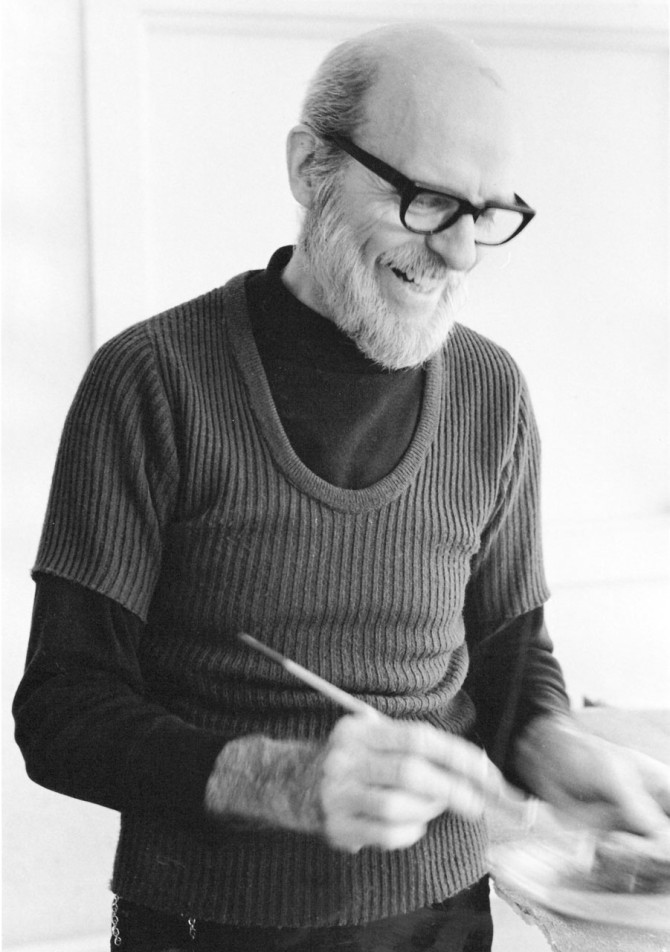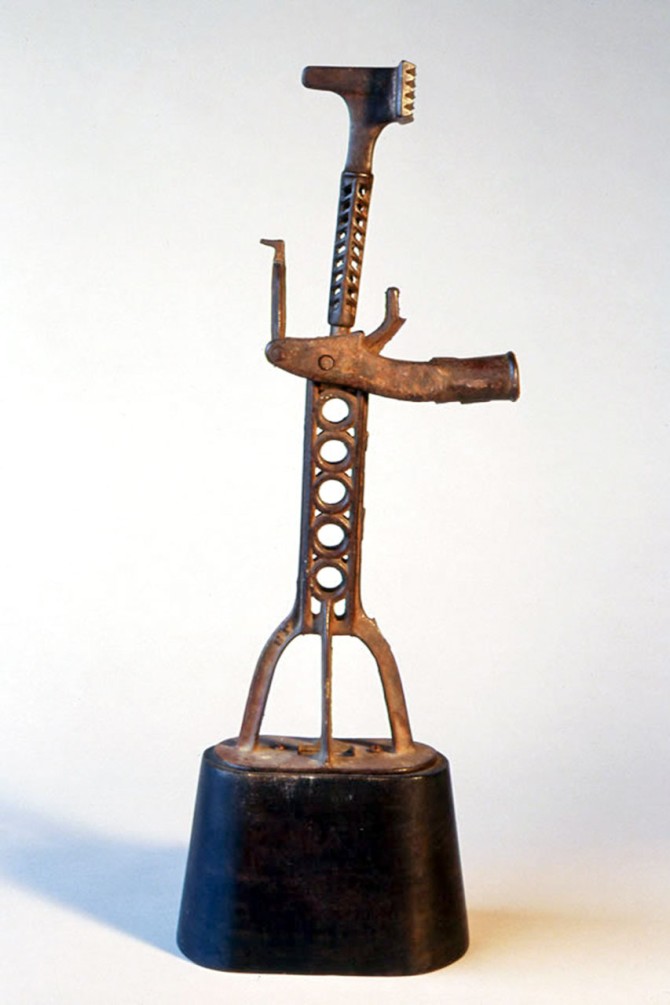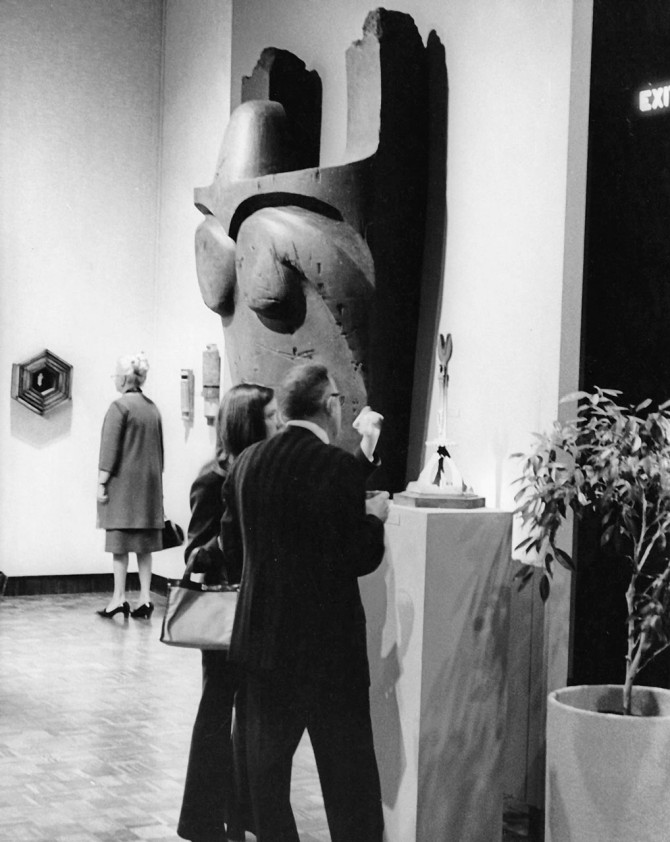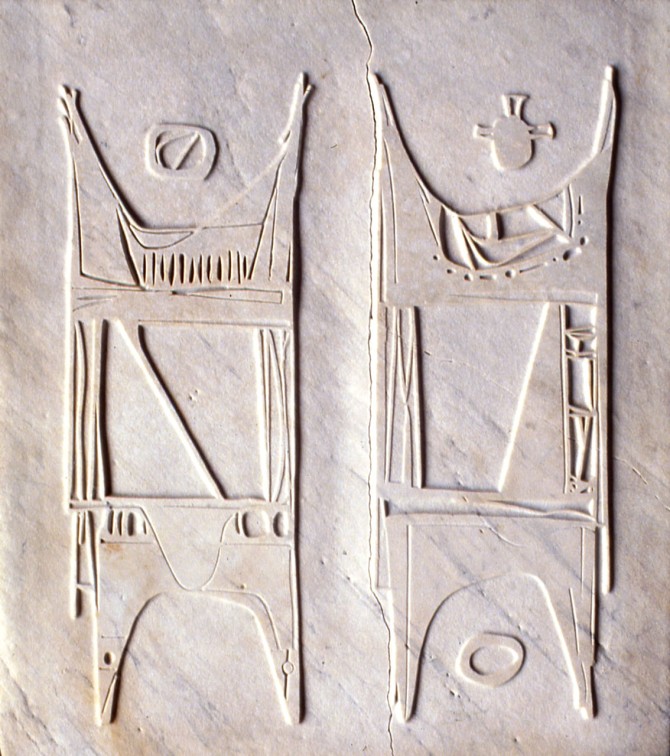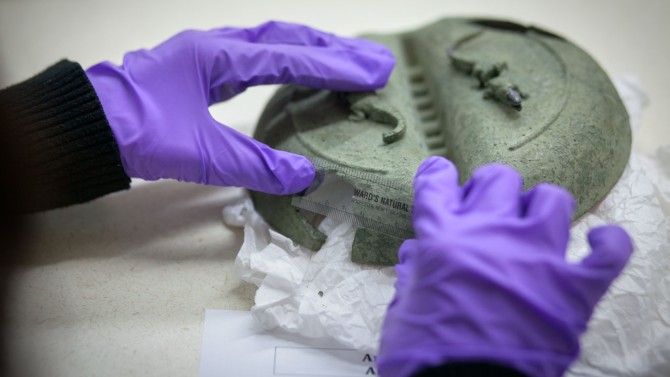Fictional civilization leaves behind lasting legacy
By David Nutt, Cornell Chronicle
Norman Daly spent years chronicling the lost Iron Age civilization of Llhuros – its relics, its rituals, its poetry, its music – as well as the academic commentary it inspired.
But the thing that makes Llhuros most noteworthy as a civilization?
It never existed.
Daly wasn’t an anthropologist or archaeologist, but an art professor who taught at Cornell for 57 years. In the late 1960s, he created more than 150 Llhuroscian “artifacts” from everyday materials and industrial detritus, all of it corroded and pre-aged to appear ancient, and he invented elaborate backstories about the culture that supposedly produced them. A small group of university and community collaborators helped him expand the project to include other kinds of media, such as sound and music.
In 1972, Llhuros was unveiled to the world in a one-of-a-kind exhibition at the A.D. White Museum of Art that didn’t announce itself as a fictional creation. Visitors had to puzzle it out for themselves. Some were baffled. Some were angry. Most were delighted.
The exhibition garnered national media coverage and led to more showings throughout the U.S. and Europe. Daly continued to expand the world of Llhuros throughout the years, but by the time he died in 2008, most of it was sitting in storage.
This fall, Cornell University Library’s Division of Rare and Manuscript Collections acquired a trove of archival materials documenting the creation of this fictional society, giving researchers and historians a detailed view into a unique project that is both an absurdist critique of academic anthropology and an attempt to draw crucial connections between the past and the present, highlighting the challenges – spiritual, political and environmental – that all societies struggle to address.
“As an archivist, and someone who’s in charge of preserving the legacy of Cornell faculty, I saw right away that this was a collection that would be wonderful to have,” said Evan Earle ’02, M.S. ’14, the Dr. Peter J. Thaler ‘56 University Archivist. “It documents just one tiny little sliver of Cornell’s history. But it’s a fascinating one.”
Planned interferences
Daly was born in Pittsburgh in 1911, the youngest of seven children. He began drawing and painting as a teenager, and received his bachelor’s degree from the University of Colorado, where he developed a formative interest in the art of the Pueblo Native Americans of New Mexico. After studying in Paris for a year on a fellowship, he earned his master’s from Ohio State University, and joined Cornell’s Department of Art in 1942.
Throughout his first two decades at Cornell, Daly focused on painting and exhibited his work professionally in New York. By the 1950s, though, he had begun to move away from it.
“He felt very, very guilty about the way he taught it. He said he was too tough on the kids when they were painting. And he felt really bad about it,” said David Borden, senior lecturer emeritus in the Department of Music, who would become one of Daly’s collaborators.
By the early 1960s, Daly transitioned to three-dimensional work, making marble bas-reliefs and sculptures out of found objects.
“It’s sort of a crazy kind of sculpture,” Borden said. “But if you make it into this other thing, like this other civilization, it’s like a dream place that he invented. It seems like he was changing his whole mental environment to get away from painting.”
During this period, Daly had a series of pivotal experiences that led him to Llhuros. While he was showing some of his work on campus, a visitor accidentally mistook one of Daly’s constructions for a hat rack. This inspired Daly to include explanatory labels to communicate with the viewer. Then, in the mid-1960s, he attended a concert of avant-garde music at Cornell.
“I was struck by how hard the audience was working to understand the music,” he said in a February 1972 interview with Newsweek, “and I thought if only I could achieve the same involvement with my work. One idea was to setup a series of planned interferences that would pique the viewer [… .] My other idea was to induce the viewer into a mental reconstruction of what he was seeing. I’d been doing found-object art out of junk, so the anthropological guise seemed perfect.”
Daly augmented this “junk” with a range of materials: Styrofoam, metal, paint, earthenware, stone, as well as commercial packaging. One of his most notable “planned interferences” was an ancient door in which the attentive viewer could notice the word “Honda” imprinted in the bas-relief; the material came from a motorcycle box. Another work, entitled “Portrait of a Man,” was a head purported to be a high priest, but was actually a plastic figurine of Pittsburgh Pirates shortstop Honus Wagner.
‘Half in jest and all in earnest’
Over roughly six years, Daly conjured an enigmatic culture he named Llhuros, using everything from gaskets and blender parts to meat tenderizers and citrus juicers to pass as its ritual objects and scientific instruments. He mapped out the geography and its cities and sacred sites. He conceived of cultural ceremonies. He wrote Llhuroscian poetry. All of these elements were organized, like any other classic anthropology, into distinct time periods – Early Archaic, Archaic, Late Archaic, Middle Period and Decline – that tracked the rise and fall of this imaginary Iron Age civilization, one that had much more in common with present day America than casual viewers might suspect.
“Llhuros is here and now – a recasting of my 60 years of experience,” he said in the Newsweek interview. “You know, people won’t listen if you talk to them seriously. My show is like that Pennsylvania Dutch expression ‘half in jest and all in earnest.’”
There wasn’t any precedent for something like Llhuros – at least not in the field of visual art. While writers such as J.R.R. Tolkien had built their own meticulous fictional worlds, Daly avoided any books or artworks that might be too similar. His sole literary influence, he once noted, was Argentinian writer Jorge Luis Borges.
Underpinning Daly’s project was a subversive playfulness that was very much part of the 1960s counterculture, with a cultural critique that transcended mere hoax.
“Norman was a lot of fun. He was very witty, with very wry humor,” said Marilyn Rivchin, retired senior lecturer in film. “And he was just full of energy. I mean, he wasn’t a kid at the time, but he was very sprightly.”
In the early ’70s, Rivchin was working as assistant to the late Thomas Leavitt, professor emeritus of the history of art and then-director of the A.D. White Museum of Art. Leavitt would later serve as founding director of The Herbert F. Johnson Museum of Art, which was still several years away from being built, and he had recently organized the landmark – and highly controversial – Earth Art exhibition. That show saw artists depositing a ton of rock salt, three thousand pounds of white sand, and a cubic yard of topsoil and peat moss on the A.D. White Museum floors, not to mention the chain-sawing of a 200-foot section of ice atop Beebe Lake and other provocative works.
Recognizing the scope of Daly’s vision, Leavitt gave him the run of two full floors of the A.D. White House – which served as the university art museum from 1953 to 1973 – to display “The Civilization of Llhuros,” and Leavitt put Rivchin in charge of organizing the show. When it came to preparing the catalog, much of their work was to camouflage the role of artist and curator.
“The exhibition itself never gave away the fact that this was a fictitious civilization,” Rivchin said. “It was Norman’s idea throughout that people would either pick up on the idea or not, and it was really up to the audience to sort of fill in the sense and the logic of the work and see that it was really more about contemporary society than it was any real, ancient civilization.”
The catalog described itself as “an exhibition of artifacts from the recent excavations of Vanibo, Houndee, Draikum and other sites” and listed Norman Daly as “Director of Llhuroscian Studies, Cornell University.” In addition to inventorying the show’s approximately 150 sculptures and paintings, the catalog contained tongue-in-cheek text descriptions, with occasional commentary from experts such as anthropologist Paver Slaban and professor Conrad Lionberger, all of whom Daly invented.
The big reveal of Daly’s ruse came at the end of the exhibition catalog, in a Q&A between Leavitt and Daly, and an afterword by the late Robert Ascher, professor of anthropology and archaeology, who wrote: “Norman Daly’s civilization is manufactured largely from the debris of our civilization; it is then reset in terms of anthropological constructs of early civilizations. But what if our constructs are myths? [… .] The debris of Llhuros, together with the commentary, becomes myth on myth.”
The ‘aha’ moment
“The Civilization of Llhuros” reflected Daly’s wide breadth of interests: painting, sculpture, music, crafts, sounds, costumes and writing. He had an autodidact’s enthusiasm for immersing himself in new fields and cobbling together his own idiosyncratic version. When he needed help, he turned to local collaborators.
In order to create Llhuroscian music and a soundscape for the exhibition, Daly conceived of a simple theme on piano and then received technical assistance from synthesizer pioneer Robert Moog to electronically alter it, disguising its origins. He also had variations of the theme sung by a women’s choir and a chorus of 6th graders.
In the early ’70s, David Borden was working out of Moog’s Trumansburg studio, and he was introduced to Daly through Linda Fisher, who performed with Borden in the band Mother Mallard and whose own mother had been one of Daly’s singers. Borden and Fisher would travel up to Daly’s studio space near the airport and watch him work. The university had rented Daly the entire ground floor of a building because his previous studio wasn’t large enough to accommodate the full-scale pieces he was creating. One temple wall, decorated in bas-relief, was 36 feet wide and nine feet tall.
“When he was working, he used to ask us if we liked this, or if we liked that,” Borden said. “And we didn’t really know what he was doing. When he showed us a few things, we thought they were really funny. And they were really well done.”
Daly asked Borden if he’d be willing to contribute some synth sounds that could mimic drums and thunderstorms.
“He said, ‘I think I can use things that play drums, if you can think of what some kind of drums would sound like, but don’t sound like drums do today.’ He didn’t know exactly what he wanted,” Borden said. “So I would bring him stuff, and he would say ‘Oh, yes, I can use that, I can use that. Just bring me more and I will figure it out.’”
Thanks to such collaborations, visitors to the A.D. White Museum were immersed in a full visual, auditory and tactile experience as they travelled through a maze of sculptures, paintings, photomontages, fragments of frescoes and temple doors and walls, while a prerecorded soundtrack provided introductory information, music and ritual chants in various rooms.
A review in Newsweek raved that “The Civilization of Llhuros” was “an archaeological magical mystery tour the like of which has never been offered before,” filled with eerie, evocative music and artifacts that were “dazzling, witty and disturbing.”
Some of Daly’s fellow academics were more than disturbed – they were outraged. The reaction delighted Daly.
“It’s such a burlesque!” he told Newsweek. “Why, after the opening, one English professor stormed into the office of Tom Leavitt and accused me of perpetrating a monstrous fraud … On one level, the show is meant to appeal to people’s need to suspend reality, to their nostalgia for things they’ve never experienced. And by using objects of modern civilization, I’ve tried to get people to rediscover the beauty of our own industrial designs.”
Over the next two years, the exhibition traveled to museums throughout the U.S., including stops in Rochester, Indianapolis, Akron and Philadelphia, and then went to Germany for a major show in Cologne, in 1974, for which Daly created new site-specific Llhuroscian material. By 1977, all of Llhuros had returned from Europe in enormous crates that were put into storage. And there, aside from one or two shows, they remained for decades.
Restlessness and new challenges
The society of Llhuros supposedly collapsed thousands of years ago for reasons that were never explained. Some theories included “extravagant gambling,” “an apathy of staggering proportions,” “the infallibility of the Llhuroscian menstrual chart” and “hedonistic indulgence of effete refinements and obsessive pursuit of sensory excitation.”
But for Norman Daly, the story of Llhuros kept growing and growing.
“In one sense or another, he never left Llhuros behind for the rest of his life,” said his son, David.
Many of Daly’s later years were dedicated to writing a play inspired by Llhuros, called “Stiltwalkers,” that went unproduced. At one point, hoping to find a museum or theatre to host the work, he shared a draft with Rivchin.
“From what I saw, it was very raunchy,” Rivchin said. “I thought ‘Nobody is going to put this on. It’s too wild.’ But maybe today somebody would.”
One of Daly’s most ambitious ideas was to build a full-scale Llhuroscian temple in which to perform the play, along with new music and dance. He applied for grants to support this and other projects, but funding never materialized.
“One aspect of his character was his restlessness and his eagerness to move on and not be stuck in a certain mode and repeat himself,” David Daly said. “And I think that was very much a determinant, if you will, to the whole career of Llhuros. He didn’t make further efforts for many years to do anything to promote it. My interpretation is that because of this restlessness he’d found this new challenge, namely the play, and that was more engaging to him than trotting out the old, whatever that might lead to.”
Even if his interest in his own accomplishments waned, Daly never lost his passion for teaching. So strong was his commitment to his students that when he had reached the university’s then-mandatory retirement age of 65 in 1976, he convinced his college to let him return as an instructor. He taught for another 24 years, finally retiring in 1999. In 2004, the Herbert F. Johnson Museum held a retrospective of Daly’s work that included a representative selection of Llhuros objects.
After he died, at the age of 96 in 2008, his son and Fisher began the arduous process of building a comprehensive website to commemorate “The Civilization of Llhuros,” including images, reviews, recordings, poetry, a glossary and even a 16mm student film of the original exhibition complete with satirical narration.
“I had read somewhere a comment by Norman in which he said, ‘You know, I can’t really believe that I was responsible for making this. It seems like it’s taken on a life of its own. And I’m just another person who’s looking at it, perceiving it,’” Fisher said. “The thing about Norman is, he just left all this stuff and went on to something else. So for us, trying to organize and find and figure it out, it’s a real challenge. But the treat for us was being able to discover for ourselves the depth and vastness of what he did, with these wonderful gaps where a visitor could sort of make up a story about what happened during that time and insert him or herself into the entire thing if they choose.”
That kind of participation, however, requires an audience. And in terms of the larger art world, the “lost” civilization of Llhuros that was Norman Daly’s life’s work appeared to be more or less lost for good.
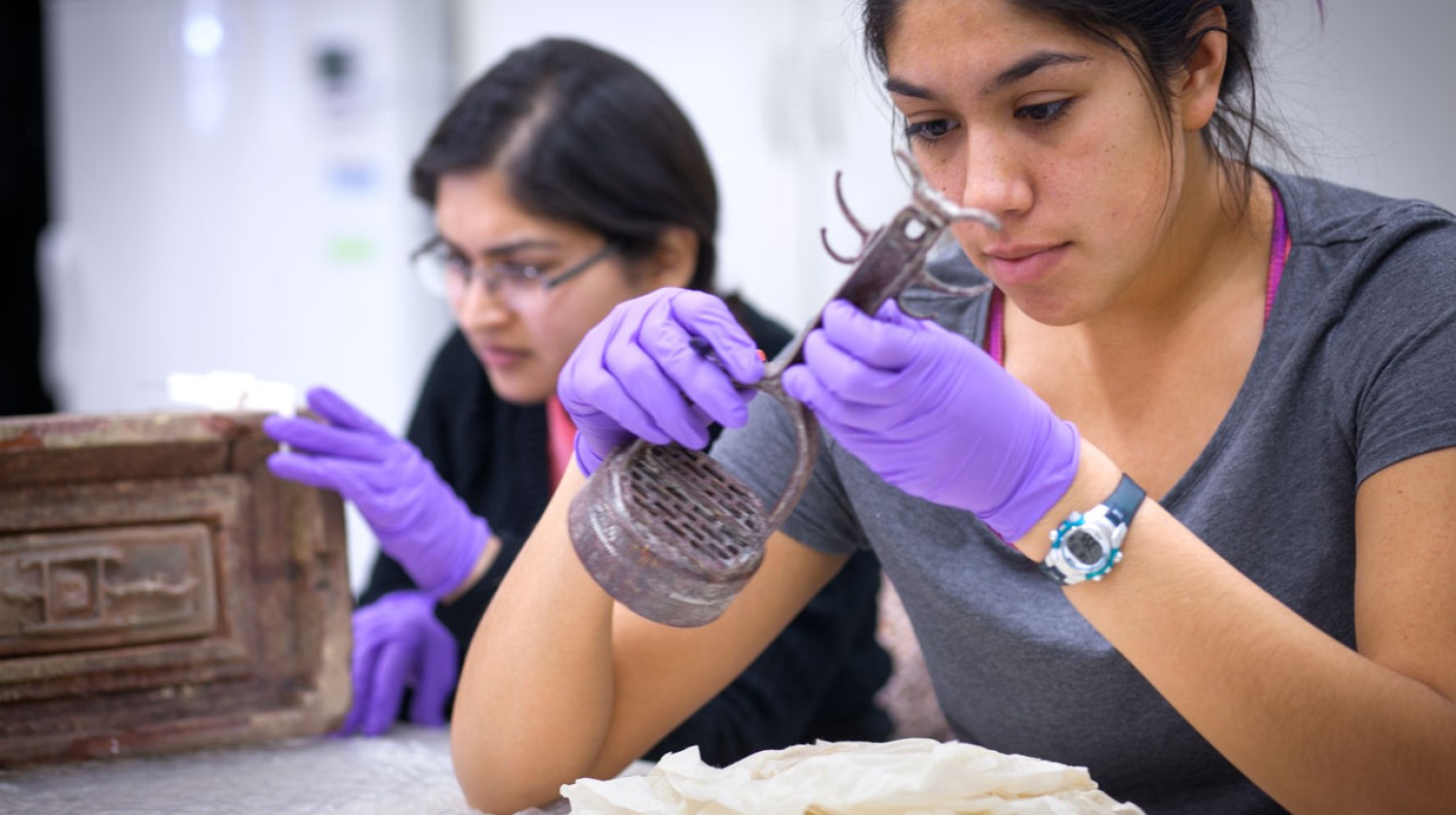
Students in professor Adam T. Smith’s “The Rise and Fall of Civilization” class examine Llhuros relics.
Rediscovery
Then, in 2017, Llhuros experienced an unexpected revival when a number of its artifacts were included in an installation at La Panacée in Montpellier, France. Two years later, more than 100 pieces were part of the 16th Istanbul Biennial at the Pera Museum in Turkey. A 2021 book, “Sting in the Tale: Art, Hoax, and Provocation” by Antoinette LaFarge, identified Llhuros as the pioneering work in the genre of “fictive art.”
That renewed interest culminated in a symposium this fall celebrating the 50th anniversary of “The Civilization of Llhuros.” The virtual event, hosted by the University of Tennessee-Knoxville’s School of Art and organized by UT professor Beauvais Lyons, featured presentations and remembrances by Fisher and Rivchin as well as LaFarge, other artists, former students and Cornell faculty Andrea Simitch, professor of architecture and Stephen H. Weiss Presidential Fellow, and Val Warke, associate professor of architecture, with discussions facilitated by former Cornell professor Buzz Spector.
As much as Daly’s project makes sport of academia, the library’s acquisition of the Llhuros material means more scholars will now be able to engage with the work. The collection includes photos of the artifacts, maps, text, recordings, old exhibition labels, Daly’s teaching materials, his early pre-Llhuros artwork, even an eight-track cassette. (“It might be the first eight track I remember bringing into the collection,” Earle said.) Since the archive is not equipped to store large three-dimensional objects, Daly’s approximately 150 handcrafted artifacts remain in a storage facility in Elmira, New York. However, David Daly and Fisher are hopeful the renewed interest in Llhuros will lead to future exhibitions and possibly a permanent home for the artifacts as well.
“I hope [the collection] can be used in many ways: for exhibition, for online productions, for education,” said Fisher, who spent nearly two years working with David Daly to strategize, negotiate and prepare the materials for transfer to the archive. “I think that all those things will be wonderful if they can move forward for research, of course. That’s why the archive is really important. They’ve allowed us to put our foot down into that world now in a formal way.”
The project has already proved to be a valuable classroom resource for Adam T. Smith, Distinguished Professor of Arts and Sciences in Anthropology in the College of Arts and Sciences, who incorporated Llhuros artifacts into his course, “The Rise and Fall of Civilization.”
Smith’s students were tasked with examining the pieces as if each were a remnant of an ancient Cornellian civilization.
“The minute you actually touch it, you actually pick it up, you begin to see the artifice behind it, you begin to recognize, ‘Oh, that’s not a fertility idol, that’s an ashtray. Or, this isn’t made out of terracotta, it’s an old Dial soap Styrofoam container,’” Smith said. “So the way in which Daly brought found objects into antiquities is a really compelling and cautionary tale about how we spin the story of civilization, often out of thinner reeds than he spun out of his materials.”
Even 50 years after its initial exhibition, Llhuros still manages to confound, amuse and, above all, enlighten.
“As an ambitious artistic installation, that both mimics the tropes of archaeology and also pokes fun at them, there is nothing like this,” Smith said. “I think it is the most original critique of the conceit of archaeology ever launched. And we should pay very close attention to it. It’s a critique that is as vital today as it was when it was first exhibited.”
Media Contact
Get Cornell news delivered right to your inbox.
Subscribe